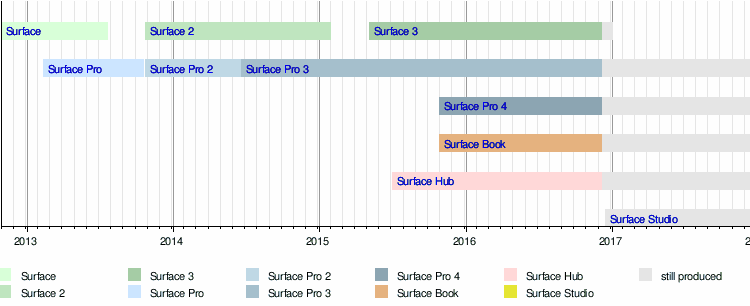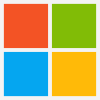Surface Hub
|
| |
|
The front face view of the Surface Hub | |
| Developer | Microsoft |
|---|---|
| Product family | Surface |
| Type | Interactive whiteboard for business |
| Generation | 1st |
| Release date | 1 June 2015 |
| Introductory price |
|
| Operating system | Windows 10 Pro |
| CPU | 4th generation Intel Core i5 (55-inch model) or Core i7 (84-inch model) |
| Memory | 8 GB |
| Storage | 128GB solid-state drive |
| Display | 55 inches (140 cm) 1920x1080 or 84 inches (210 cm) 3840x2160 screen, both with 120 Hz refresh rate, 16:9 aspect ratio and 100-point multi-touch sensor |
| Graphics | Intel HD Graphics 4600 (55-inch model) or Nvidia Quadro K2200 (84-inch model) |
| Sound |
Dual front-facing speakers Quad microphone array |
| Input |
Sensors: passive infrared presence, imaging, ambient light and depth sensors |
| Controller input | Surface Pen |
| Camera | Front wide-angle camera (2): 5 MP, 1080p HD |
| Connectivity |
Wireless: 802.11 a/b/g/n/ac Wi-Fi Bluetooth 4.0 Low Energy NFC reader Miracast Ports: 2 × full-size USB 3.0 2 or 4 × full-size USB 2.0 Gigabit Ethernet DisplayPort 3.5 mm audio socket RS-232 serial port RJ11 connector for system level control |
| Online services | Windows Store, OneDrive, Skype for Business, Groove Music, Xbox Games, Microsoft Movies & TV |
| Dimensions |
55-inch model: 59.62 inches (151.4 cm) (width) 31.75 inches (80.6 cm) (height) 3.38 inches (86 mm) (depth) 84-inch model: 86.7 inches (220 cm) (width) 46.12 inches (117.1 cm) (height) 4.15 inches (105 mm) (depth) |
| Weight |
48 kilograms (106 lb) (55-inch model) 127 kilograms (280 lb) (84-inch model) |
| Website |
www |
| This article is part of a series on the |
| Microsoft Surface |
|---|
The Surface Hub is a brand of interactive whiteboards developed and marketed by Microsoft, as part of the Microsoft Surface family. The Surface Hub is a wall or roller stand mounted device with either an 84 inches (210 cm) 120 Hz 4K or a 55 inches (140 cm) 1080p touchscreen with multi-touch and multi-pen capabilities and runs the Windows 10 operating system.[1] The devices are targeted for businesses to use while collaborating and videoconferencing.
History
Microsoft first announced the Surface Hub at its Windows 10 Devices Event on January 21, 2015, at which the device was hidden in plain sight and in use throughout the majority of the keynote.[2] Microsoft began taking Surface Hub pre-orders on July 1, 2015 for both the 55 inch model and the 84 inch model, stating that they would begin shipping in September 2015.[3] However, on July 13, 2015, Brian Hall, an employee at Microsoft on their Surface Blog, announced that pre-order demands had greatly exceeded Microsoft's predictions and that shipments of the Surface Hub would be delayed, with more details regarding the delays coming in mid-August 2015.[4] Further details confirmed that Microsoft had delayed shipment until January 1, 2016,[5] but that date wasn't met either. Instead, Microsoft announced that there were further delays and that they would be raising the price by $2,000, though they would still honor the previous price agreement with previous pre-orders.[6] The Surface Hub began shipping to business customers on March 25, 2016.[7]
Features
Hardware
Both Surface Hub models are powered by the 4th generation Intel Core Haswell processors (Core i5 for the 55-inch and Core i7 for the 84-inch) and runs the 64-bit version of Windows 10 Pro. The main differences between the two variants are screen size, resolution and its graphics adapter. The 55-inch model supports 1920x1080 Full HD and contains a Intel HD 4600 controller integrated in the CPU, while the more expensive 84-inch model has 3840x2160 4K resolution powered by a Nvidia Quadro K2200 discrete graphics adapter.[8] Microsoft Surface Hub has dual cameras built into the device. When used for videoconferencing, the cameras can automatically change when the presenter moves from one side of the whiteboard to the other.
The screen of both models has a high-quality display, though it is not meant to be used for movie or TV screening. The screen is able to get very bright (reaching 424.38 cd/m2 at its brightest), but its black levels, are quite low (1.58 cd/m2). As a communications device, the screen can be viewed clearly at any angle. The screen has a matte finish which allows it to be less susceptible to glare. Additionally, the screen has a “100-point multi-touch projective capacitance optically bonded sensor” and a 120 Hz refresh rate, which allows it to detect what input is being used on the screen, whether it be a stylus or fingers.
There are wide-angle HD cameras on either side of the hub with a 100 degree field of view. The cameras produce pictures at 1080p and 30 fps and are enabled with a four-element microphone array. Inside the cameras are sensors for ambient light and infrared presence. The hub knows when to turn on or off based on the light level in the room, and can also turn on based on the presence of infrared, or when someone enters the room. According to Microsoft, the four-element microphone array can detect a whisper from 23 feet away, but from PC Magazine’s tests of the Hub, a more realistic estimation is about 15 feet away.[9]
Software
The Surface Hub runs Windows 10 Pro.
JT2GO (Developed by Siemens) allows users of the Surface Hub to interact with a 3D model. The models can be viewed from any 360 angle view and be enlarged or reduced in size in real time. The application can be used on all Windows 10 devices but is particularly useful on the Surface Hub. Skype for business video conferencing will be included with the Surface Hub. Microsoft OneNote allows users to draw on the screen. Files can be easily shared with anyone who uses OneNote, including users with smartphones, tablets or laptops on any operating system, including Windows 10 Mobile and iOS. Microsoft Office applications can also be used, including Microsoft Word, Microsoft PowerPoint and Microsoft Excel.
The Hub specializes in 3 main themes: talking, drawing and sharing. The Hub’s welcome screen has three buttons: "call," "whiteboard" and "connect." Each of these functions can be used individually or simultaneously.[9]
Timeline

Source: Microsoft Devices Blog
See also
References
- ↑ Ian Cutress; Andrei Frumusanu (2 March 2015). "Microsoft at MWC 2015: Lumia 640 and 640 XL Announced, 4K 120Hz Surface Hub Demoed". AnandTech. Retrieved 3 March 2015.
- ↑ "Microsoft announces Surface Hub, hides it in plain sight throughout the event". Neowin. Retrieved 2016-04-18.
- ↑ "Microsoft has opened the door for Surface Hub pre-orders". Neowin. Retrieved 2016-04-18.
- ↑ "Surface Hub delayed, shipping details to come in August". Neowin. Retrieved 2016-04-18.
- ↑ "Microsoft is delaying Surface Hub shipments until January 1, 2016". Neowin. Retrieved 2016-04-18.
- ↑ "Microsoft has delayed the Surface Hub once again, while raising the price by $2000". Neowin. Retrieved 2016-04-18.
- ↑ "After a number of delays, Microsoft begins shipping Surface Hubs". Neowin. Retrieved 2016-04-18.
- ↑ "Hub Technical Specifications". Microsoft.com. Retrieved 2 October 2015.
- 1 2 Muchmore, Michael. "Microsoft Surface Hub". PC Magazine. Retrieved 15 July 2016.

